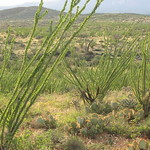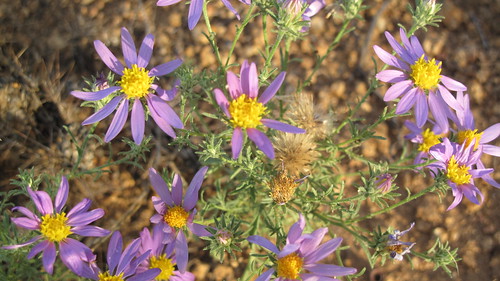 One of the most common misconceptions about the Sonoran Desert held by those who’ve never lived here is that there are no seasons. Isn’t it just hot and dry all year long? Maybe a little less hot in “winter?”
One of the most common misconceptions about the Sonoran Desert held by those who’ve never lived here is that there are no seasons. Isn’t it just hot and dry all year long? Maybe a little less hot in “winter?”
Of course, we don’t get the spectacular fall foliage that blankets states such as Vermont in swaths of yellow, red, and orange (unless you head to our nearby mountains . . . ). But nature compensates us for that: We get two springs.
The geography of the Sonoran Desert region, while it restricts the overall amount of rain that falls each year, breaks what does fall into two major periods—one in July and August, another in December and January. The summer rainy season is characterized by brief, powerful thunderstorms that originate in the tropical Pacific Ocean or the Gulf of Mexico; winter rains are usually more gentle and of longer duration (and, of course, colder), and sweep down from the northern Pacific. In good years each season will result in about four or five inches of rain—perhaps 10 inches annually. Not much by the standards of Vermont residents, who’d cry “Drought!” if they failed to get three times that amount—but desert plants and animals have evolved to exploit every drop.
Just as importantly, the Sonoran Desert region represents the meeting of two major North American plant communities: temperate species, many of which reach their southern extent here, and subtropical species, which hit their northern limits around our latitude. The temperate species, in general, evolved to do the majority of their leafing, growing, and blooming in the early part of the year. The subtropical species are adapted to a rainy season concentrated in summer—many of them ignore the traditional spring and wait until July or August to produce flowers or even leaves.
 What that means is that in February and March we enjoy a massive bloom of wildflowers such as California poppies, evening primrose, lupine, owl clover, and brittlebush, among dozens of others. A month later cactus and ocotillo will blossom just as vibrantly, if more sparsely, and mesquite trees will leaf out. In late April, palo verde trees explode in yellow blooms, and ironwood trees display delicate lavender flowers in May.
What that means is that in February and March we enjoy a massive bloom of wildflowers such as California poppies, evening primrose, lupine, owl clover, and brittlebush, among dozens of others. A month later cactus and ocotillo will blossom just as vibrantly, if more sparsely, and mesquite trees will leaf out. In late April, palo verde trees explode in yellow blooms, and ironwood trees display delicate lavender flowers in May.
Then, in another two months, after residents have survived the dry 100º-plus temperatures of June, and massive thunderheads release their loads in stunning downpours during July, a second miracle occurs. Summer poppies, prickly poppies, chinchweed, Coulter’s and rock hibiscus, and devil’s claw all recognize their own spring and present us with a second, more subdued but just as lovely burst of flowering.
Even those two springs don’t comprise all our growing seasons. Many Sonoran Desert plants are opportunistic—they’ll leaf or bloom whenever there is sufficient rainfall. Spindly, spiny ocotillos—not cactus but in their own family—begin growing new leaves within 24 hours of a rain, and develop a full set in less than a week, completely altering the appearance of the plant and, indeed, the entire desert where thick stands are present. A month later the plants will be bare again, only to repeat the process with new rain. Many flowering plants such as desert zinnias exploit both springs, and the hardy desert marigold can bloom several times a year given frequent precipitation. In fact, the mild desert climate means that something is leafing or blooming virtually any month of the year. December? Desert broom produces its version of a snowstorm, wafting thousands of white seed pods downwind. January? Cottonwood trees along riparian corridors and washes think that’s a fine time to grow new leaves.
So Sonoran Desert residents have a simple response when friends from Vermont or other northerly states email us photos of fall colors with teasing comments about our seasonless home. We just wait until, say February, when those friends are digging out from five feet of snow.
Then we email them photos of us running through fields of poppies wearing shorts and T-shirts.
